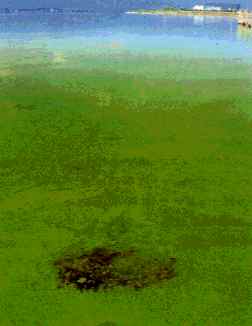Water / Soil / Ground Environment
State of Japan's Environment at a Glance: Japanese Lake Environment - Deteriorating Lake Environments
Deteriorating Lake Environments
Lake environments in Japan changed greatly with rapid economic growth. Land reclamation in lakes was prevalent in many parts of Japan during the 1950s for increased flood production; this increase led to lake shrinkage and dramatic change of lakeshore ecosystems. Furthermore, the level of water transparency in lakes dropped during the 1950s and 1960s. In the 1960s, the Convention to prevent pollution of Lake Konstanz (the world's first convention for lake water quality) marked the beginning of major efforts initiated in Europe and the USA to recover the environment including basins and lake surroundings. In the 1970s, water bloom, symbol of deteriorating water quality, occurred in many lakes throughout the country. In the 1980s, countermeasures for basin and lake problems were initiated through water quality conservation plans based on the Clean Lakes Law, and eutrophication prevention measures were introduced by local authorities.
Chronological Table of Lake Environment Conservation
| Japan | International | |
|---|---|---|
| 1950s | (Land reclamation projects to increase rice production) | (Acidification of Lago d'Orta due to factory wastewater discharged) |
| 1958 | Enactment of Water Quality Conservation Law and Factory Effluent Control Law | Halting of copper sulfate dumping in Lake Mendota as a measure against water bloom |
| 1960s | (Water transparency level in many lakes dropped from prewar levels) | Convention for preventing pollution of Lake Konstanz |
| 1962 | (Dams constructed at numeral sites such as Kurobe) | Convention for preventing pollution of Lac Leman |
| 1970 | Enactment of Water Pollution Control Law Establishment of Environmental Quality Standards on Water | (1970s Success story of Environmental Management Program of Lake Tahoe) |
| 1971 | Inauguration of Environment Agency | Adoption of Ramsar Convention |
| 1972 | (Large-scale water bloom outbreak in Sagami Reservoir.) | Establishment of UNEP |
| 1973 | (Large-scale water bloom outbreak in Kasumigaura Lake) | |
| 1977 | (Freshwater algal bloom outbreak in Biwa Lake) | |
| 1978 | Convention for Water Quality Management of Great Lakes | |
| 1979 | Enactment of Ordinance Concerning the Prevention of Eutrophication of Lake Biwa (Shiga Pref.) | (1970s Ecosystem of Scandinavian lakes destroyed by acidification) |
| 1980 | Ratification of Ramsar Convention | (1980s Extreme eutrophication occurred in many lakes of developing countries, including China) |
| 1982 | Enactment of Ordinance Concerning the Prevention of Eutrophication of Kasumigaura Lake (Ibaraki Pref.) | (1980s Water level drops in Lake Chad due to drought) |
| 1984 | Enactment of Clean Lakes Law (Environment Agency) First World Lake Conference at Lake Biwa | |
| 1985 | Establishment of nitrogen and phosphorous control standards for lakes and reservoirs (Environment Agency) | |
| 1986 - 7 | Institution of First Phase Water Quality Conservation Program for lakes under the Clean Lakes Law (each Pref.) | |
| 1992 | Enactment of Ordinance on Conservation of Reed Colonies in Lake Biwa (Shiga Pref.) | |
| 1992 - 3 | Institution of Second Phase Water Quality Conservation Program for lakes under the Clean Lakes Law (each Pref.) | Adoption of Agenda 21 at UNCED (1990s Water hyacinths invade and multiply in Lake Victoria |
| 1993 | Fifth Ramsar Convention Meeting in Kushiro | |
| 1994 | Enactment of Environmental Basic Law (Environment Agency) | (1990s Sedimentation problem become serious in many US reservoirs) |
| 1995 | Sixth World Lake Conference at Kasumigaura Lake. |
Changes in Lakeshores
The Ministry of the Environment of Japan receives annual reports concerning lake water quality from prefectures and holds the Green Census every few years. According to the Green Census, the status of Japanese lakeshores is as follows: 58.7% are natural lakeshores, 11.8% semi-natural lakeshores (artificial constructions within 20 meters from the lakeshore), and 28.7% artificial lakeshores (more than 50% percent of shoreline is artificial). Many artificial-shore lakes are inland sea lakes in the plain areas. From 1979 to 1985, the number of "changed" lakes increased from 19 to 27. Many of the natural-shore lakes are found in Hokkaido Pref.
Invasion of Exotic Species

Water bloom outbreak in Lake Biwa
Concerns over the disturbances to the original ecosystems of lakes have been raised because of the increase of the introduction of fish species including black bass in lakes across Japan. Aquatic weeds also add to this disturbance. Large outbreaks of Elodea (native aquatic weed of USA, which entered Japan around 1960) and Egeria (native aquatic weed of South America, which entered Japan from 1968) occurred in Biwa Lake. The weeds washed up onto the lakeshore and caused a foul odor. Also, from 1992 onward, a freshwater mytilid mussel (Kawahibari-gai; southeast Asian origin) was found in the Lake Biwa-Yodo River system, the Nagara River, and the Ibi River system. There is concern that these mussels may attach to the inside of water pipes and interfer with water flow.